5 Easy Employee Fitness Challenges for Your Office
Last Updated Jul 3, 2025

Workplace wellness challenges sound great on paper. But without the right support, they often fizzle out—leaving HR leaders frustrated and employees unmotivated.
Low participation. One-size-fits-all formats. A few highly active employees dominate while others feel left behind. The result? Missed opportunities for real connection, engagement, and impact.
With the right strategy, fitness challenges can become a powerful tool for culture-building. The key is designing them to be inclusive, flexible, and aligned with your team’s unique needs. That’s when the shift happens: from a fleeting activity to a meaningful part of your wellbeing program.
Elevate your strategy with wellness challenges that actually work for every employee.
What You'll Learn
- Wellness Challenges Drive Real Behavior Change: Thoughtfully designed fitness challenges can lead to sustained improvements in physical activity, diet, stress management, and sleep — even for previously inactive employees.
- Strategic HR Impact: Wellness programs contribute to reduced healthcare costs, lower turnover, and higher employee satisfaction — making them essential tools for HR leaders focused on long-term people strategy.
- Inclusive Design Is Key to Participation: Effective challenges are flexible, accessible, and tailored to diverse needs, with options that support different work settings, mobility levels, and wellness goals.
- Execution Makes or Breaks Engagement: Success depends on using the right tracking tools, proactive communications, inclusive rewards, and equal access for all employees — regardless of location.
- Easy-to-Run Challenge Ideas for Any Team: From step goals and mindfulness months to bingo boards and “beat your baseline” personal goals, there are ready-to-use formats that are low-lift for HR and inclusive across your workforce.
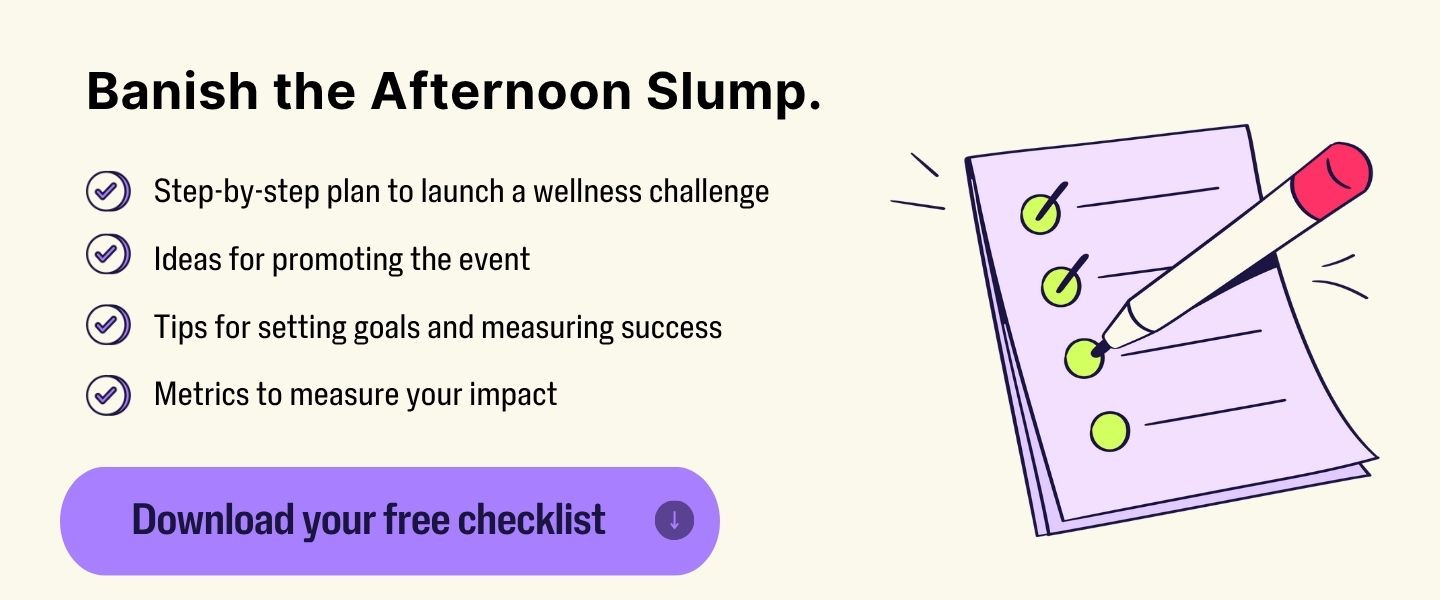
Why Fitness Challenges Matter
Wellness challenges do more than boost morale. They lead to lasting improvements in employee health, which moves the needle on strategic HR objectives.
Employee Health
In a randomized workplace trial, participants in a six-week challenge saw statistically significant improvements in multiple wellness areas, including:
- Physical activity
- Diet
- Stress levels
- Oral health (yes, even flossing!)
- Sleep quality (which showed a positive trend)
And you know what’s especially exciting? These effects were observed immediately after the challenge and they persisted six weeks later. Whether employees completed the challenge individually or with peer support, the outcomes were the same: better health behaviors across the board.
The numbers tell a powerful story:
- Employees who were invited to join the wellness challenge were more than 8 percentage points more likely to exercise regularly than those who weren’t (69.8% vs. 61.9%).
- They were also over 13 percentage points more likely to actively manage their weight (69.2% vs. 54.7%).
- After adjusting for baseline health and demographics, participants reported about half a day more of exercise per week compared to their non-participating peers.
And the biggest gains came from previously inactive employees, the very group that wellness programs often struggle to engage. While they were less likely to join, those who did showed the most progress.
Participants also rated the program highly. It was seen as easy to take part in, low-cost, and a meaningful step toward better wellbeing — making it a sustainable and scalable strategy for any workplace.
Bottom line: When done right, wellness challenges don’t just engage your workforce. They empower lasting behavior change — and help you build a culture where wellbeing is part of the everyday routine.
HR Goals
Wellness challenges promote healthier habits like regular movement and better nutrition. That means fewer claims and lower long-term medical spend.
In fact, 91% of HR leaders say their wellbeing program helps reduce healthcare costs, with 78% of them seeing measurable drops in spending.
This supports strategic cost management and gives HR more room in the budget for other high-impact initiatives.
Employees who feel well are more likely to stay. They’re more productive, take fewer sick days, and report higher satisfaction.
- 98% of HR leaders say wellbeing programs reduce turnover
- 89% of HR leaders say they lead to fewer sick days
- 88% of HR leaders say they’re essential to employee satisfaction
- 80% of CEOs say their wellness program is a highly effective talent attraction tool—with 42% calling it “extremely impactful.”
- 66% of CEOs say employees would consider leaving if their company doesn’t prioritize wellbeing. That belief is strongest at small companies: 67% say they agree or strongly agree that employees would leave without a focus on wellbeing, compared to 63% in medium and 59% in large companies.
That’s more than wellness. That’s a retention strategy in action.
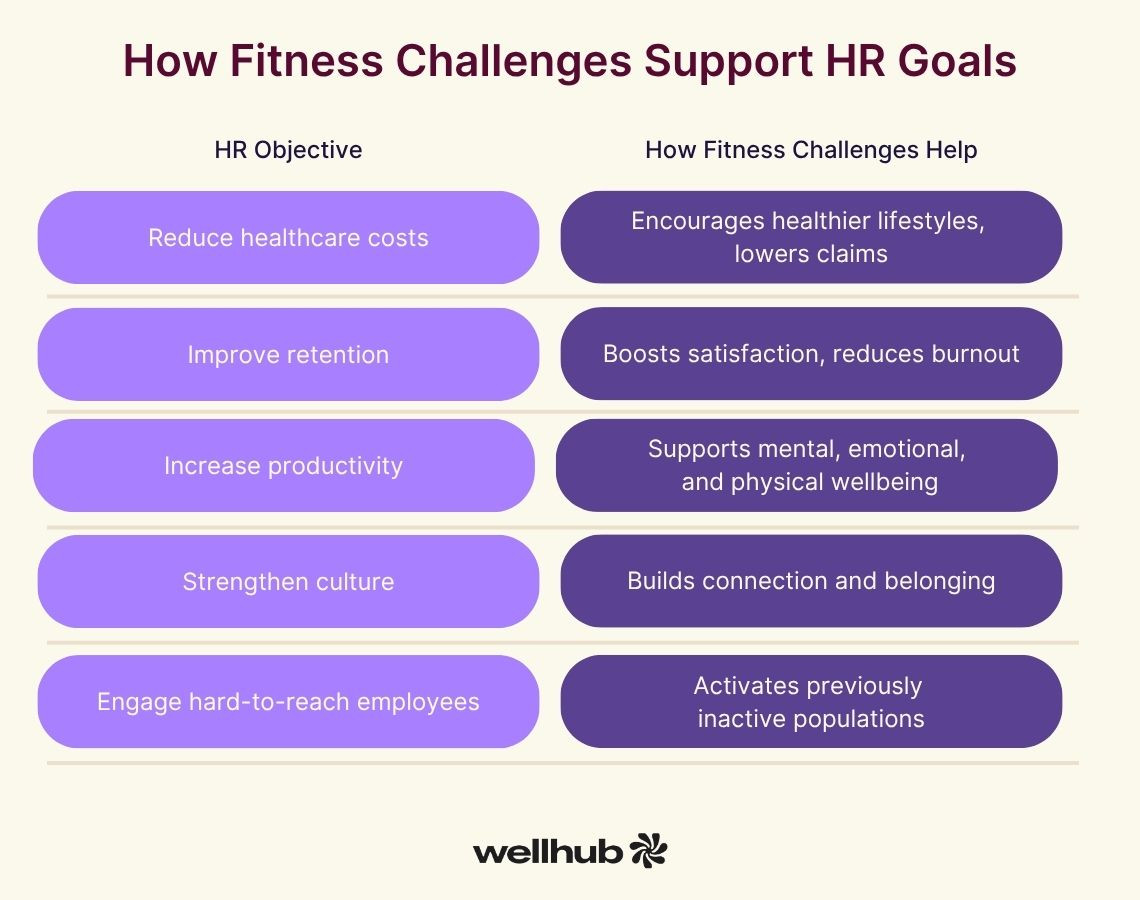
Challenges that address mental wellbeing — like mindfulness or movement — help reduce burnout and elevate performance.
95% of employees say their emotional wellbeing affects productivity, and 60% say stress-related loneliness makes them less effective at work.
When HR helps employees manage stress, it directly supports engagement, output, and innovation — all key metrics for talent development.
Wellness challenges bring people together — across departments, seniority levels, and locations. That drives connection and belonging, especially in hybrid and remote environments.
Belonging has a business case. Employees with a strong sense of community are:
- More likely to be engaged
- More likely to stay
- More likely to perform
And when they don’t feel that? They’re up to five times more likely to be job hunting.
The Strategic Takeaway for HR:
If you’re building a people strategy that’s sustainable, measurable, and human-centered, wellness challenges belong on your roadmap.
How to Design an Inclusive Fitness Challenge: A Step-by-Step Guide
Step 1: Set the Right Goals
Before choosing the format or length of your challenge, ask yourself: What are we trying to achieve, and for whom?
Inclusive goals prioritize accessibility, wellbeing, and connection over competition. Try these on for size:
- Increase team connection across departments.
- Promote holistic wellness—mental, physical, emotional.
- Offer something fun and low-pressure during high-stress times (like quarterly close or year-end).
Pro Tip: Use SMART goals. For example: “We want 60% of employees to log three wellness activities per week for four weeks.”
Step 2: Choose the Right Duration
Time is one of the top reasons employees skip out on wellness. In fact, 56% of employees say time constraints keep them from exercising more often Wellhub's State of Work-Life Wellness 2025!
That’s why shorter or more flexible timelines are your friend.
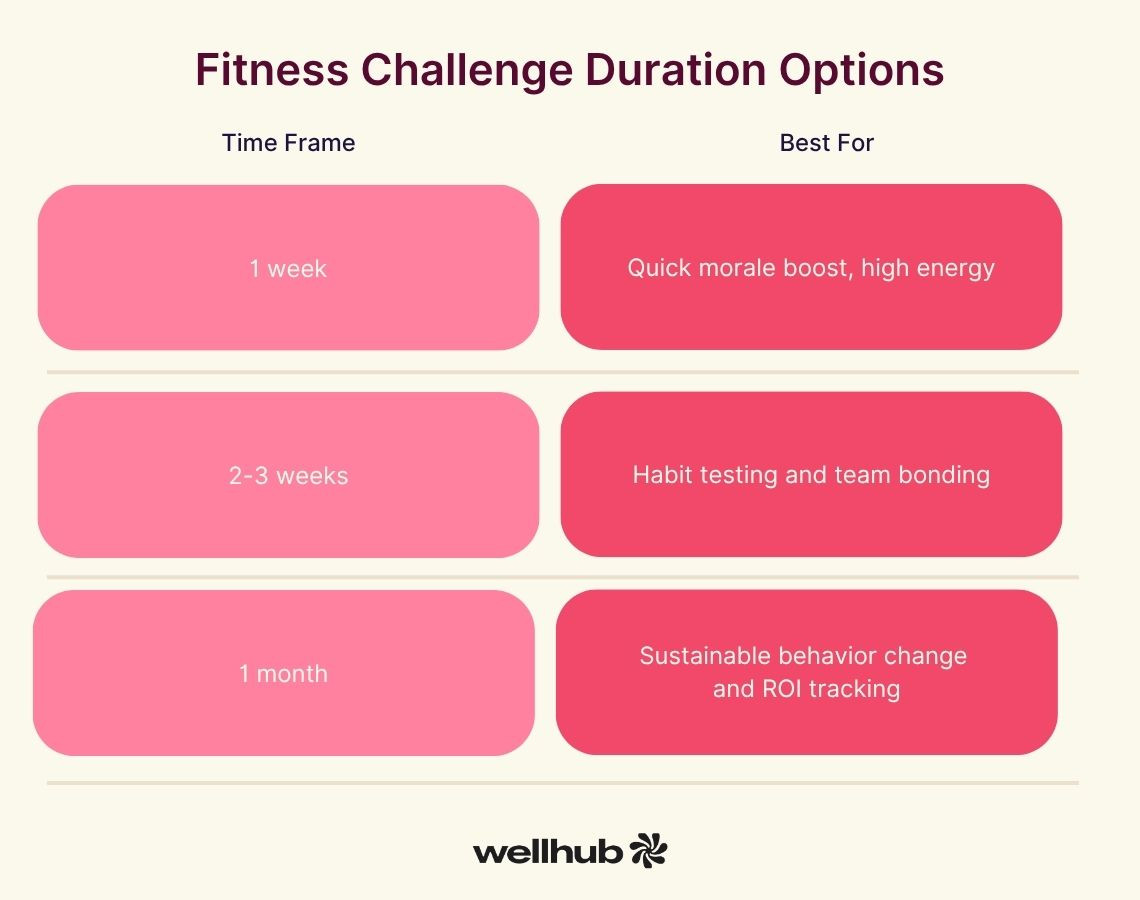
Stick with something that respects your team’s bandwidth, while still giving them room to grow.
Step 3: Offer Flexible Formats
Inclusion = Options. Let employees choose their own path to wellbeing.
Here are a few examples to offer side-by-side:
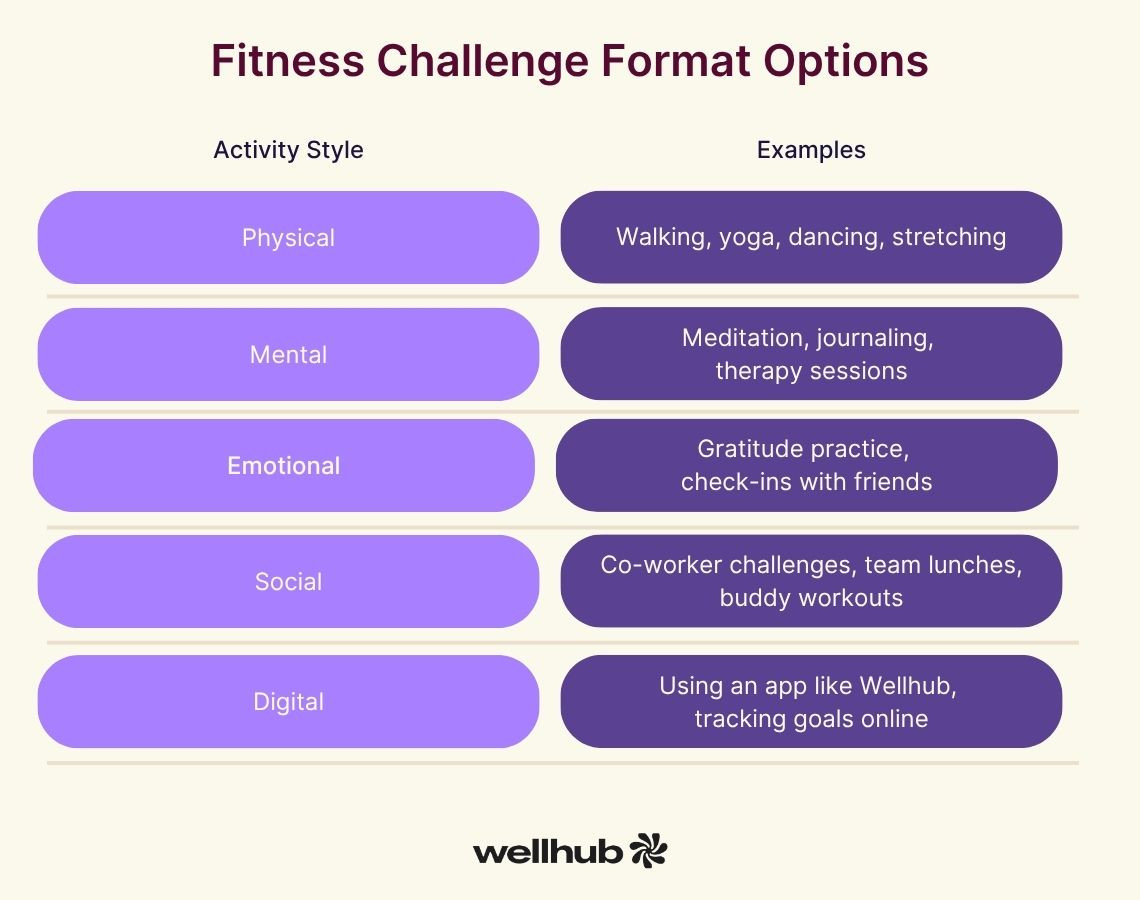
Inclusivity means designing for hybrid, in-office, and deskless workers alike. Offer both individual and team-based modes so introverts and extroverts feel equally welcome.
Step 4: Form Teams Thoughtfully
Team structure can make or break your challenge’s inclusivity.
Try these team-building tips:
- Cross-functional pairings help employees connect across departments.
- Let people opt in to team or solo play—not everyone wants to “win.”
- Assign team leads or wellness champions to encourage participation without pressure.
- Create space for identity-based teams, like ERGs or affinity groups, to connect around shared goals.
And don’t forget the magic of a strong team name: “The Stretch Goals,” “Zooming to Zen,” or “Cardio Queens” can make teams feel proud and connected.
How to Execute a Fitness Challenge and Drive Engagement
Designing a great fitness challenge is like setting the stage.
Now it’s time to raise the curtain and get everyone excited to participate. These four components will help you run a challenge that’s fun, fair, and full of momentum.
Step 1: Use the Right Tools for Tracking
Tracking is what turns a challenge into a movement. It gives employees a clear way to log activity, stay accountable, and celebrate wins.
Here are your go-to tracking options:
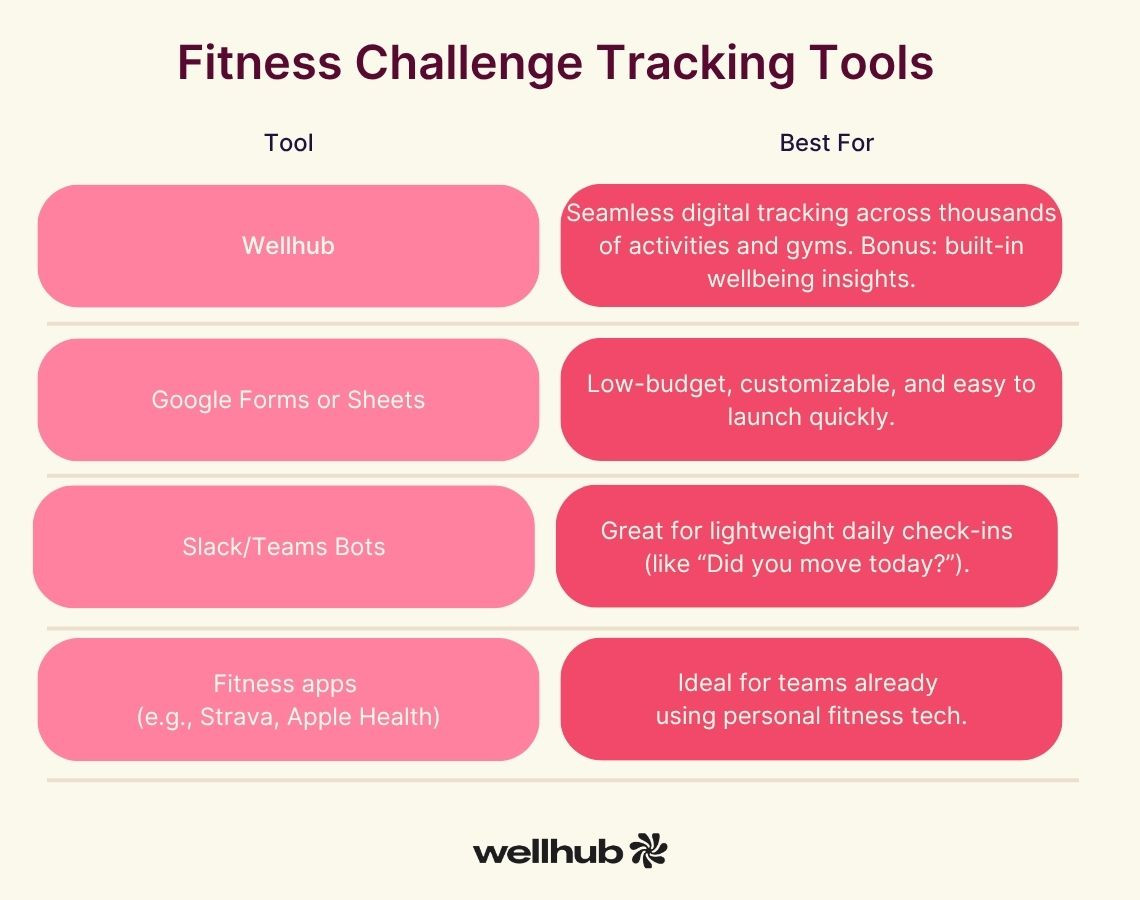
💡Pro Tip: Pick tools that work across devices and environments, especially if your workforce is hybrid or deskless.
Step 2: Build a Proactive Communication Strategy
A challenge with no buzz is a challenge no one joins.
Here’s a simple three-phase plan to drive signups and momentum:
Before Launch:
- Tease the challenge in internal comms (email, Slack, digital signage).
- Share stories or stats on why fitness matters.
- Host a quick Q&A or kickoff call to answer questions.
During the Challenge:
- Share weekly leaderboards and shoutouts.
- Spotlight teams or individuals with creative participation.
- Drop motivational messages or tips (e.g., “Try a 5-minute desk stretch today!”).
After the Challenge:
- Celebrate everyone — not just the winners.
- Share impact stats (e.g., total minutes logged, most popular activity).
- Highlight testimonials or photos from participants.
Your goal: Make every employee feel like they belong in the challenge — not just the athletes.
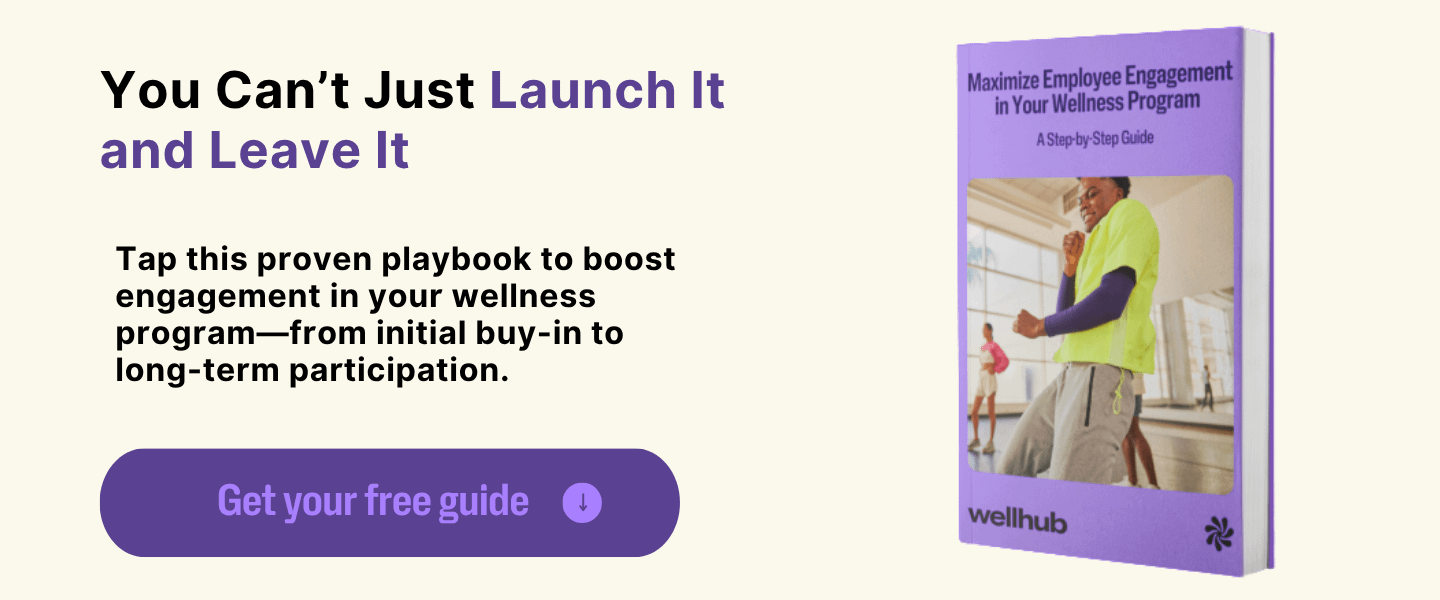
Step 3: Offer Inclusive Rewards and Recognition
Recognition makes people feel seen. Rewards give them a little extra incentive. The trick is to make both inclusive and meaningful.
Inclusive reward ideas:
- Extra PTO or wellness days
- Charitable donations in the winner’s name
- Wellhub membership upgrades
- Recognition in all-hands meetings or newsletters
- Wellness kits (stretch bands, journals, water bottles)
Recognize more than just “most points”:
- Most consistent
- Best team spirit
- Most creative activity
- Most improved
When you broaden the definition of success, everyone has a reason to stay in the game.
Step 4: Ensure Equity for Remote and Hybrid Teams
Here’s where many companies drop the ball — but not you. Inclusion means making sure location never limits participation.
How to make it fair for all:
- Offer virtual kickoff and wrap-up events.
- Design challenges that can be completed from anywhere — walking, stretching, dancing, mindfulness, and more.
- Use digital tracking tools accessible on any device.
- Rotate times for live events so different time zones can join.
- Offer physical swag and incentives shipped to all participants.
If you’re sending goodies to HQ, send them to remote folks too. Visibility matters — and no one should feel left out.
5 Easy Challenge Ideas to Try With Your Team
If you want to launch a wellness challenge but need ideas that are easy to run, low-lift for HR, and inclusive across your entire workforce — these five challenge ideas are for you.
Each one works whether your team is in the office, remote, or a mix of both. And best of all? They’re designed to be fun, flexible, and totally customizable
- Step Challenge
The Classic for a reason. A step challenge is the ultimate crowd-pleaser because walking is universal. You don’t need gear, a gym, or even a ton of time — just a goal and a way to log progress.
How to run it:
- Set daily or weekly step targets.
- Track via Wellhub, Apple Health, Fitbit, or a Google Sheet.
- Offer team-based and individual awards (like “Most Consistent” or “Top Steppers”).
Why it works: It’s low-pressure, easy to access, and taps into people’s natural sense of competition and community.
- Mindfulness Month
Because wellness isn’t just physical. With47% of employees saying stress is harming their emotional health, it’s time to make mental wellbeing part of the challenge mix.
How to run it:
- Offer daily prompts: 5-minute breathing, gratitude journaling, or short guided meditations.
- Use Slack check-ins or a mindfulness tracker.
- Host optional live sessions with a coach or meditation app.
Why it works: It's inclusive of all mobility levels and gives employees tools to carry forward even after the challenge ends.
- Wellness Bingo
Turn healthy habits into a game! Bingo is visual, engaging, and wonderfully flexible.
How to run it:
- Create a bingo board with 25 wellness actions (like “drink 8 glasses of water,” “go outside on your lunch break,” “compliment a coworker,” or “stretch for 5 minutes”).
- First to 5 in a row = mini prize. Full board = bigger reward.
Why it works: Bingo makes participation feel like play — and it supports all dimensions of wellbeing (physical, social, emotional, etc.).

- Beat Your Baseline
The challenge that personalizes success. Instead of competing against others, employees set their own goals, and try to beat themselves.
How to run it:
- Have employees choose one behavior to track for 2–4 weeks (steps, sleep, water, workouts, mindfulness minutes).
- Week 1 is baseline. Weeks 2–4 are the challenge.
- Celebrate improvement at any level.
Why it works: It’s goal-setting meets self-care. It honors where each employee is and helps them grow from there.
- Cycle-to-Work (or Wherever)
A challenge that pedals toward both fitness and sustainability. Even if people don’t commute, they can bike around their neighborhood, town, or trails.
How to run it:
- Track miles biked using apps like Strava or Google Sheets.
- Offer categories like “Most Miles,” “Weekend Warrior,” and “New Cyclist.”
- Encourage photo sharing of scenic routes.
Why it works: It’s energizing, environmentally friendly, and builds a sense of local pride — especially if employees share their city’s best hidden bike paths!
BONUS: Mix & Match!
Want even more impact? Combine ideas! For example:
- Week 1: Step challenge
- Week 2: Mindfulness bingo
- Week 3: Beat Your Baseline
- Week 4: Celebrate with team awards
Use Wellness Challenges to Build a Healthier, More Connected Workplace
Fitness challenges offer more than just fun and team bonding. They help reduce stress, support better health habits, and bring teams together in a meaningful way. But without structure, they can fall flat.
A comprehensive employee wellbeing program turns fitness challenges into a strategic asset. These programs empower all employees — regardless of fitness level, schedule, or location — to engage in wellness their way. This inclusivity builds stronger workplace culture and better outcomes. In fact, companies that invest in Wellhub can see up to a 35% reduction in healthcare costs and a 40% drop in turnover.
Speak with a Wellhub Wellbeing Specialist to launch a holistic wellness program that supports challenges to energize your workplace!

Company healthcare costs drop by up to 35% with Wellhub*
See how we can help you reduce your healthcare spending.
[*] Based on proprietary research comparing healthcare costs of active Wellhub users to non-users.
References
- Tomayko, E., et al. Effectiveness of a tracking-based wellness challenge to promote health behavior change. (2020). Health Behavior and Policy Review, 7(4). https://doi.org/10.14485/hbpr.7.4.8
- Song, Z., & Baicker, K. (2019). Effect of a workplace wellness program on employee health and economic outcomes. JAMA, 321(15), 1491. https://doi.org/10.1001/jama.2019.3307
- Wellhub (2024, May 16). Return on Wellbeing 2024. https://wellhub.com/en-us/resources/research/return-on-wellbeing-2024/
- Wellhub (2025, June 18). Return on Wellbeing 2025. https://wellhub.com/en-us/resources/research/return-on-wellbeing-2025/
- Wellhub (2024, October 16). The State of Work-Life Wellness 2025. https://wellhub.com/en-us/resources/research/work-life-wellness-report-2025/
Category
Share

The Wellhub Editorial Team empowers HR leaders to support worker wellbeing. Our original research, trend analyses, and helpful how-tos provide the tools they need to improve workforce wellness in today's fast-shifting professional landscape.
Subscribe
Our weekly newsletter is your source of education and inspiration to help you create a corporate wellness program that actually matters.
By subscribing you agree Wellhub may use the information to contact you regarding relevant products and services. Questions? See our Privacy Policy.
Subscribe
Our weekly newsletter is your source of education and inspiration to help you create a corporate wellness program that actually matters.
By subscribing you agree Wellhub may use the information to contact you regarding relevant products and services. Questions? See our Privacy Policy.
You May Also Like

How to Organize a Step Challenge at Work | Wellhub
Implementing a step challenge at work is a great way to engage employees in healthy competition while encouraging physical wellbeing.

How To Host a Hydration Challenge at Work | Wellhub
Proper hydration can boost performance through improved cognitive function. Hosting a hydration challenge at work can help encourage water intake.

Wellness Initiatives that Boost Productivity & Retention | Wellhub
From weekly stretching sessions to mental health support, explore wellness that fosters a positive company culture.